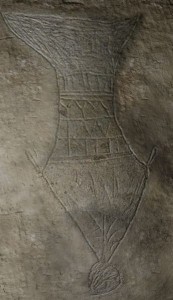I posted this over on the ASOR blog in the comments, but I feel I should also share it here in more elaboration:
 |
| What is this? |
If you’re not aware, Simcha Jacobovici and James Tabor believe this is a fish. Specifically, the whale that swallowed Jonah. That “ball” at the bottom? They believe it’s Jonah’s head, wrapped in seaweed, being spat out upon land.
I believe that this is a better metaphor to understand the current problem with that conclusion:
(Especially pertaining to Jonah’s head. Or should I say ‘skull’? Wait until about 0:28 and you will see *precisely* what I mean).
 |
| (HT to Tom Verenna for an excellent infographic.) |
That aside, in the proper orientation, the lines of different texture are most consistent with layered patterns produced by potters and glass workers ubiquitous to the era. (As many other scholars have pointed out.)
If this — as a fish — is “a first” (as Dr. Tabor calls it) even a casual observer should see a bright, red flag: If this is without precedent and we have nothing to compare it with, standard procedure is to observe extreme caution before we make any unusual or sensational claims.
As the matter stands, we have many, many examples of pottery and other vessels on ossuaries and they look more like this image than anything else (in structure, motif, and function). With that precedent, I would feel it’s the safer and more likely conclusion.
The “Fish Hypothesis” (on the other hand) requires treating the inscription’s details as a bit of a Rorschach, which flings us from the stage of scientific inquiry and thrusts us into a completely different field altogether.
 |
| No, not this Rorschach. But if you messed with him, you might end up in an ossuary yourself. |
UPDATE: Robert Cargill has written an amazing exposé on how the images have been altered digitally. I can only concur with his analysis as the hallmarks of photoshopping are all too prominent.
Peace,
-Steve “I don’t see the skull” Caruso, MLIS
